Between moving into a different role in my day job and going to the USA for a few weeks (I’ll share my detailed itinerary in another post soon if anyone’s interested), my absence here was due to one other big thing… selling my investment property.. without a real estate agent.
I know this post won’t appeal to everyone but if you’re thinking of selling your property yourself now or might in the future, I hope you find this post hopeful!
This post is quite long so I’ve broken it into sections
- Why I chose to sell my property without an agent
- Sell yourself companies I considered
- Property listing description template I created (which you can modify for your own property)
- Photos for the listing, including recommended posting order
- How to create the floor plan
- Staging the property
- Pricing the property
- Countdown / timeline
- Checklist
- Collateral you can make yourself
- How I kept track of all the people that were interested in the property
- Property info sheet
- How I made a ‘please remove your shoes’ sign
- How I made the for sale flyer
- How and when I held the open homes
- How I kept everything organized
- Email templates you can use
Why I chose to sell my investment property without an agent
I’ve been to many open homes over the years from purchasing my own place and helping find a place for my sister. One thing that stood out was just how little real estate agents actually do. They’d stand there and hand you a flyer that usually doesn’t contain all the information you need. Then when you ask them a question e.g. how much are the body corporate fees? They usually couldn’t tell you and would need to ‘ask the owner and get back to me’… which they rarely actually did.
I was quoted 2 – 3% sales commission + marketing costs from 3 different real estate agents. If we took a hypothetical $500,000 sale price, that would be about $15,000 plus marketing costs. That’s a lot of money! I divided the amount I was quoted by my hourly rate at my day job and looked at the number of hours. I thought, I think I can sell it myself in about a third of that time. Why am I slogging it out at my day job for x weeks to pay someone to do something I can do myself? And then I don’t have the hassle of everything coming via a real estate agent who you never know if they’re telling you the full story. I’d rather see for myself how many buyers and the types of buyers coming to inspect, choose the open home times and just communicate directly with buyers instead of waiting for a real estate agent to get back to me.
I think there’s a perception that real estate agents do a lot… but most of the work is actually done by the solicitor, or can be done by yourself. I live in Queensland, Australia and here all a real estate agent really does is:
- Free appraisal of the potential selling price (which in my case, wasn’t even accurate, multiple agents quoted me $50k+ below the price I manged to sell it for)
- Create a flyer using a pre-made template and have the flyers printed
- Put up the for sale sign (although in a hot market many didn’t even bother putting a sign up)
- Organizing photos to be taken
- Uploading photos, writing and uploading the property listing description onto realestate.com
- Holding some open homes
- Following up with potential buyers
- Negotiating a sale price
None of the above requires a degree or specialist training… and yet the price they charge is insane. The only law / specialist related task they do is pre-filling some fields in a standard REIQ Contract which I paid only $150 AUD + GST for a conveyancer to do.
These are the spreadsheets I used to manage my investment property for 7 years (I did a detailed tutorial of how I use them in this post).
The spreadsheets are available in my online store
Sell property yourself companies I considered:
I make recommendations for many companies in this post – none of these are affiliate links, just resources I found helpful.
Note: I’m located in Australia so some of these companies may not be available if you live in another country.
If you want to put a listing on realestate.com, domain etc. you need a real estate agent’s licence. If you’re not using a real estate agent, you can use one of these sites (who do have a real estate agent’s licence) to get the listing posted online.
- sale by home owner
- for sale by owner
- buy my place
- property now
- sell my own place
- Agent in a Box
I ultimately ended up choosing for sale by home owner, however I wouldn’t use them again. The listing was only $700 until sold (so the listing is live for as long as you want) with no commission fees or any other costs – just the $700. The main reason I wouldn’t choose them again is their customer service:
- I was drafting the listing in the back end of the website and the next day I started getting buyer enquiry emails. The company had set my listing live. I hadn’t even provided any of the identification documentation yet. Their response was oops, we’ll hide the listing. Hide being the keyword. When I wanted the listing to go live a week later, my listing was already pushed to the bottom of the first page of search results because of their error. I asked for some compensation e.g. 1 week premier listing for free and they refused.
- Slow to respond to enquiries
- Signs are included however I had to chase them up to ask how to get them. Only when I asked were they like oh we have to ship them, send us your postal address (like they were hoping I wouldn’t ask for signs so they wouldn’t have to pay to make them or post them).
- Nowhere on the website did it say that stakes to put up the for sale sign are excluded. All they gave me were zip ties to tie it to a fence which (especially if you’re selling an apartment like I was), isn’t always practical. Since I complained they appear to have updated their website to state they don’t send stakes with the signs
- I had to request the weekly campaign statistics report that’s included in the package and wait for sale by home owner to email it to me. It was just a 1 pager from real estate.com which wasn’t much help
If I was to sell a property again, I would use for sale by owner (I know the names are very similar – it’s confusing) as they were far more responsive to questions. Their cost was a bit higher at $969 until sold however it included a 1.2m high signboard which they put up for you and more ongoing customer service / support. Some of the for sale by owner companies say they’ll help you draft your property listing but if you just look at some other properties for sale or review the template I provide late in this post, you can quickly just write your own listing.
They’ll post the advert on multiple websites but the only ones I received buyer enquiries from were realestate.com and domain.
I tested for sale by home owner’s webpage if someone wanted to make an offer, but the test never arrived in my inbox (I checked my spam and junk folder too), so I created my own offer template and told buyers to email it directly to my email address.
Here’s my side by side comparison (right click the image and choose ‘open in new tab’ to view an enlarged version).
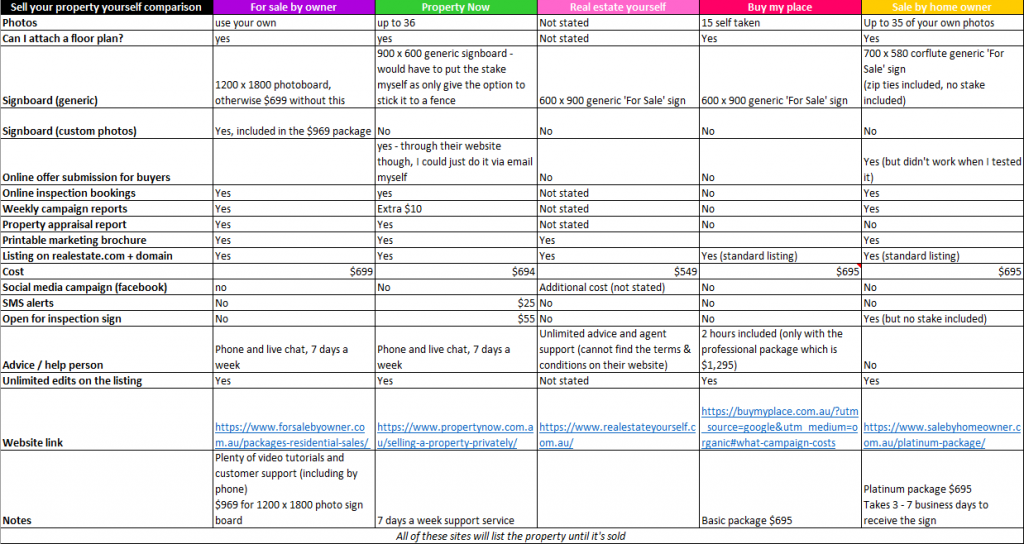
Countdown / timeline
From listing the property it took 2 weeks to get the first Contract signed. That Contract fell through due to the buyer being unable to obtain finance. It took another 3 weeks to get the 2nd Contract signed. It was then another 4 weeks for settlement. So the total process took about 9 weeks.
I put together the below checklist so I didn’t forget anything. A printable version of this checklist is available in the free printables library.
Checklist
One month (or more) before you want the listing to go live
- Review the market (currently for sale and recently sold) to get an idea on sale price
- Complete any necessary repairs e.g. dripping tap, broken fence
- Decide how much you’re willing to spend on improvements such as replacing carpet, repainting walls, installing a new fence and arrange to have these completed
- Arrange for floor plan of the property to be prepared
- If staging, request quotes, choose a supplier and lock in a date
3 weeks before you want the listing to go live
- Notify property manager and issue form 10 to notify tenants that you’re selling
- Request entry notices be issued to the tenants at least 24 hours before each open home
- Write the property listing description
- Have the property listing description proof read by someone else
- Declutter and put items in storage
- Improve landscaping if required e.g. fresh mulch, add some flower pots
- Arrange for photos to be taken (and virtually staged or edited to remove furniture, if applicable)
- Choose terms of conditions for the sale
- Choose ideal settlement date
- Research & choose conveyancer
- Obtain a copy of the Contract from the conveyancer
- Obtain vendor disclosure statement from body corporate
2 weeks before you want the listing to go live
- Follow up on any outstanding info e.g. Contract from the conveyancer
- Draft standard email responses to buyers e.g. when their offer is too low
- Save files in an online folder where you can send a link to potential buyers
- Make the property flyer
Day the listing goes live
- Property listing description is correct
- Check the photos are in the correct order
- Floor plan has been uploaded
- Listing is visible on property websites (get a friend to double check)
- Put up ‘for sale’ sign in front of property
Negotiations / Property goes unconditional
- Double check the Contract terms are what has been verbally agreed with the buyer
- Email a copy of the Contract to the buyer
- Buyer signs and send back the Contract
- Check the buyer’s signed copy, if satisfied, then sign the Contract
- Email a copy of the signed Contract to Conveyancer
- Notify your bank (if your Conveyancer hasn’t already done this)
- Add the finance clause, building and pest and any other important dates to your calendar
- Arrange time with the buyer for building and pest inspection
- If you’re moving, arrange for moving truck, sign lease on new property, start listing items on eBay, Gumtree, Facebook Marketplace etc.
Days leading up to settlement
- Check mortgage discharge statement – loan payout figure & account details are correct
- Make sure the conveyancer and bank have the PEXA number
- 3 days before – confirm everything is ready for settlement
- Review the pre-settlement statement
- Arrange time to give keys to the buyer
After settlement
- Put sold sticker on the sign, take a photo and take the sign down
- Cancel landlord’s insurance
- Cancel contents insurance
- Update the real estate listing to show sold
- Notify body corporate committee and have yourself removed from mailing and email correspondence
- Transfer funds to high interest earning account
- Check mortgage discharge amount in your bank account matches the discharge statement
I’ve included far more items in my pre listing and open home checklists.
I was selling my investment property so didn’t need to worry about organising a moving truck, but if you’re selling your own home, I do have a moving planner (or moving planning spreadsheets if you prefer to plan digitally) and a garage sale planner.
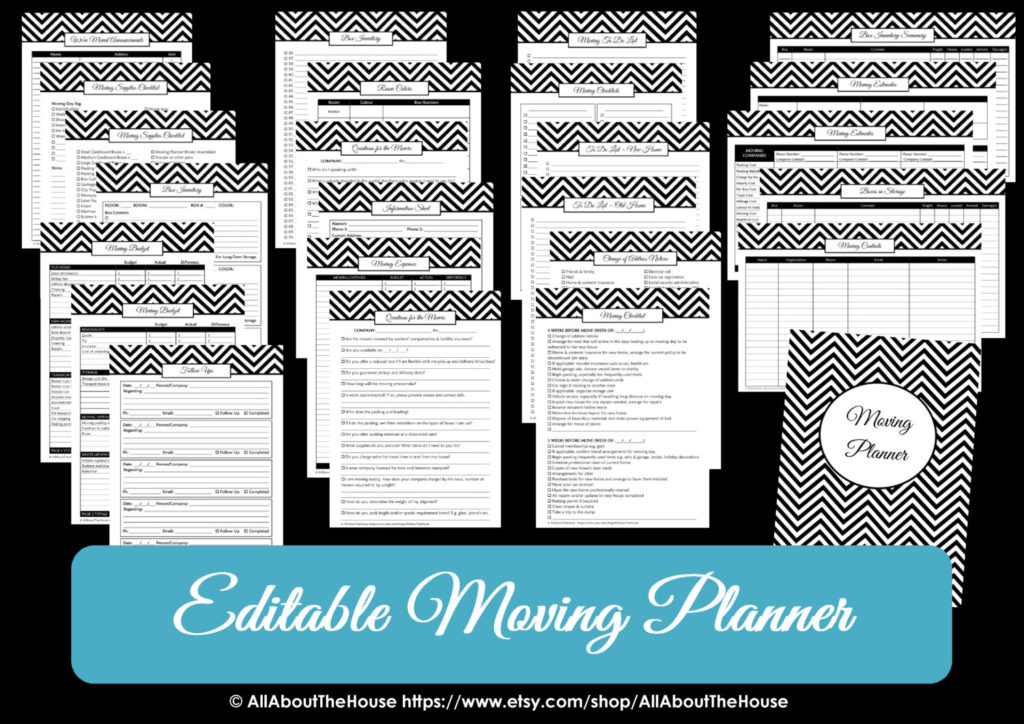
Property Listing Description
I don’t want to post my exact listing as I’d like to keep the address of the property private, but here is a template structure that I used for my property.
Introduction
Highlight the main features e.g. modern, north facing, within x km of the CBD, nearby public transport, schools and major shopping centre/s)
Property features
List these in dot points including:
- Number of bedrooms and whether they can each fit a queen or king size bed
- Any recent upgrades e.g. ceiling fans installed in (year)
- Smoke alarms compliant with 2022 legislation for landlords
- Kitchen appliances all replaced within the last 5 years
- Air conditioning in (main bedroom only, or all bedrooms, living room etc.)
- Any unique features e.g. only apartment in the complex with a large courtyard, established vegetable garden etc.
- Not located in a flood zone
- No property easements
- 1 secure basement carpark
- Area of the property – __m2 internal, __m2 external, __m2 carpark = ___m2 total
- Land size & topography of the block e.g. gently sloping
Nearby amenities
List these in dot points including:
- Major shopping centre
- Specialty stores such as hardware, fast food outlets, bottle shops, hairdressers, dentists, orthodontists, podiatrists, doctors and gyms are all within a __ minute walk (or drive) of the apartment
- x minutes walk to (name) train station
- x minutes walk to nearest bus station
- x minutes drive to (name) of major arterial road
Nearby schools
- List the school catchment/s
- List the names of the schools and the distance and driving time from the property for each
Investors
- Mention the potential rent per week / month
- Is the property currently vacant or tenanted?
- Is the property furnished or unfurnished?
Body corporate
List the following key information in dot points
- Body corporate = approx. $__ / quarter
- Council rates = $__ / quarter
- Water = approx. $___ / quarter
- The building was last repainted in (year)
- Balance of sinking fund & admin fund at (state the date) was $_____
Pet Owners
Are pets allowed under body corporate? If so, mention that here.
A typical day in your life could look like
Have the buyer picture themselves living there by highlighting the best parts of the property and / or the reasons why you’ve liked living there.
Some examples:
- x minute commute to the city via (state method of transport)
- Visit xx cafe for brunch and take your pet and / or children to the nearby park on weekends
- Stop by the grocery store on your way home from the train station or bus stop
- Relax by the communal pool on a Sunday afternoon
Photos for the property listing
Most of the sell the property yourself sites allow an unlimited number of photos to be uploaded. It obviously depends on your type of property, but these are the photos I would include. If you’re only allowed a certain number of photos, I’ve numbered the order of importance I recommend.
- Main feature of the property e.g. large courtyard, pool, kitchen etc.
- Kitchen
- Living and dining room
- Exterior photo from the street
- Floor plan
- Main bedroom
- Yard
- Shed and any other external structures
- Bathroom
- Ensuite
- WIR
- Bedroom 2
- Study
- Location map (with a key showing proximity to schools, public transport, shops and other items of interest). I did this using Google My Maps
I considered adding a photo which was just text listing out distances to things (like is stated in the listing) but it looked a bit boring with all that text so I left it out.
Floor Plan
Here are some Australian companies I found that can do this for you.
Note: most of them put their watermark on the floor plan so you may find other companies that can create a floor plan for you as you do your market research and search listings on real estate.com
I used the same floor plan the person that I bought the property from had used for their listing. It didn’t have dimensions on the floor plan which I found annoying when I was buying and I did receive numerous questions from buyers asking for a floor plan with dimensions. If I did it again, I’d pay to get a floor plan done up with the dimensions.
Staging the property
I received home staging quotes ranging from $2.500 to $5,500 for a 2 bedroom apartment. I ultimately decided not to stage the property. The photos taken by the person I bought the property from lived like they were in a display home, so I just reused those photos to save money.
If I didn’t have those photos from the previous owner, I would’ve done virtual staging which I’m seeing a lot more of in real estate listings. Some companies I found that offer this:
Many of these virtual staging websites can also delete items out of photos if you want to show what the rooms look like when vacant, or remove tenant’s personal belongings from photos.
Pricing the property
I’d been watching my local market for years so had a really good understanding of sold prices for my type of property in the area. Some other resources you can use are:
- Domain’s suggested pricing
- Sold history on realestate.com
- ANZ buy now ready report (if you’re located in Australia)
- Your bank (they have access to property databases and will be doing their own valuation before they approve the loan)
I deliberately didn’t put a price on the property when I listed it and instead said ‘make an offer’. I had seen a real estate agent repeatedly doing this and ‘for sale by negotiation’ and selling properties for slightly higher than market value. It did create a lot of interest but attracted too many lowball offers for me. After 3 weeks I put ‘offers over $__’ which weeded out unsuitable buyers.
To help guide my pricing, I used the upfront & selling costs tab of my property investment spreadsheets. When I first bought the property I recorded stamp duty, conveyancer, lender fees etc. which form my cost base.
I recorded my selling costs (conveyancer, flyers, mortgage discharge fees etc.) so I knew the portion of sale profits that would go towards paying for that.
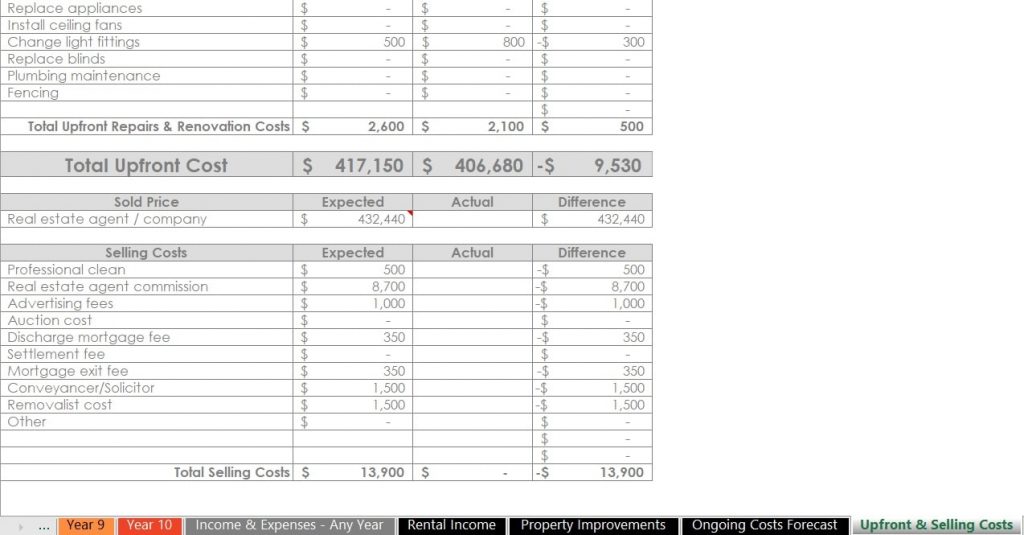
The spreadsheets are available in my online store
Collateral I made myself
- Spreadsheet to store name, phone number, email addresses, notes (e.g. person asked if body corp. would allow a pet)
- Template for people to write their name, email address and phone number
- Instructions for using the intercom which I left by the front door of the building
- Please remove your shoes sign
- Would you like to make an offer info sheet
- Property flyer
- Open home checklist
- Pre-settlement / countdown to settlement checklist
- Conveyancer comparison
- Spreadsheet to calculate capital gains tax including selling costs and scenario calculations
I also made a comparable sales brochure but didn’t end up using it. I choose to put ‘make an offer’ on the listing to test the market and see where the offers landed. Predictably there were some very low ball offers (e.g. $50 – $100k below want I thought the property was worth!) Maybe the comparable sales brochure would’ve helped
Contacts
I created a simple template in Microsoft Excel for people to fill out at the open home (table with columns for name, email address, phone number, questions).
Which I then imported into a spreadsheet I made in Google Sheets (I’ve changed the names to fake names to protect people’s privacy).
I used these colour codes:
- Grey = person not interested
- Green = person interested, need to follow up
- Orange = waiting reply e.g. tried to call & follow up but they did not answer, or haven’t received a reply to my email

Information Sheet
I made an information sheet which I gave to potential buyers and listed the following:
- Body corporate fees
- Quarterly rates
- Quarterly water bill
- How to make an offer
- Current weekly rent + tenancy end date
- A URL link to the folder I created using Sync (which is an online file storage) where they can download photos, floor plan, how to make an offer and the Contract
I deliberately didn’t put anything about the price I wanted for the property, so that buyers would have to come and ask me and I could ask them how much they thought the property was worth.
I didn’t put any effort into the the information sheet, I just did a text only flyer in Microsoft Word.
Please remove your shoes sign
I made this in 5 minutes in Canva. I just googled ‘feet’, picked an image and added some text. I used a flyer holder from Officeworks that I had leftover from the Planner Markets.
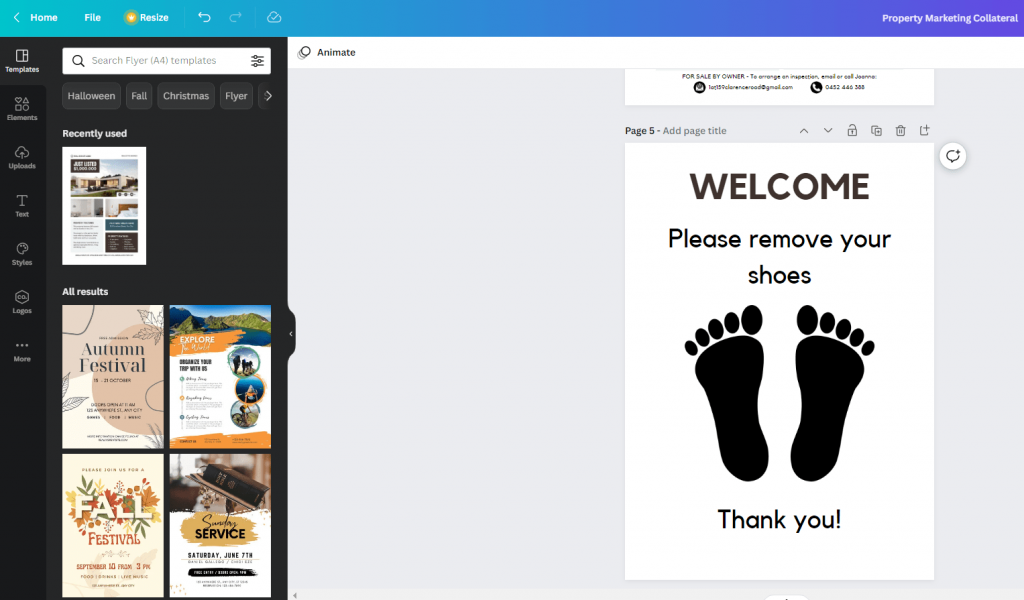
Making the flyer
I have Photoshop and Affinity Publisher which are normally my defaults, but I thought I’ll get some inspiration first which led me to Canva’s pre-made templates. I ended up customising one of those to create my flyer.
Here was the original template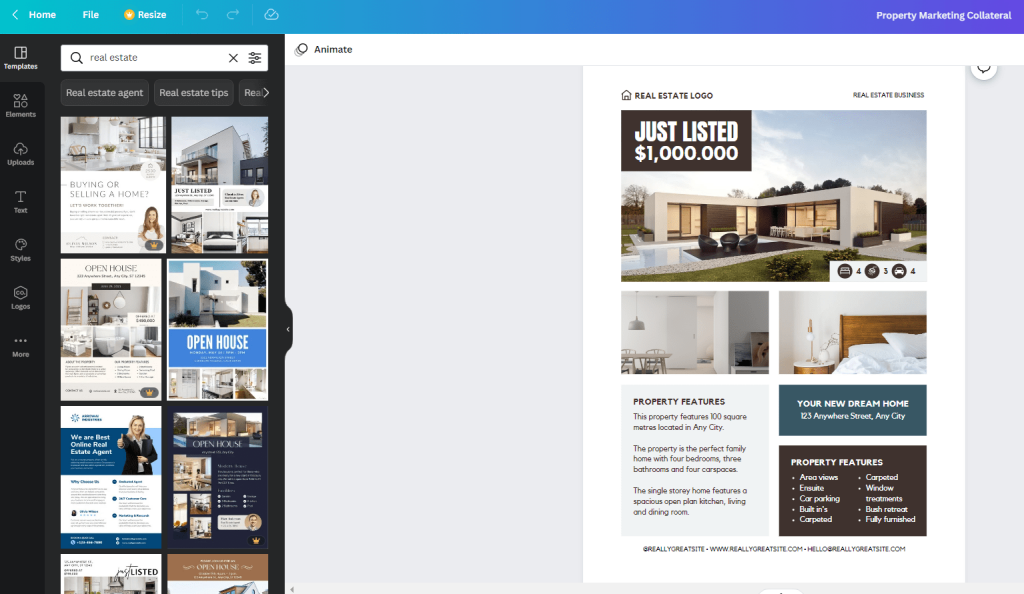
Here is my flyer (with stock photos and wording change as I don’t want to put the property address on the internet)
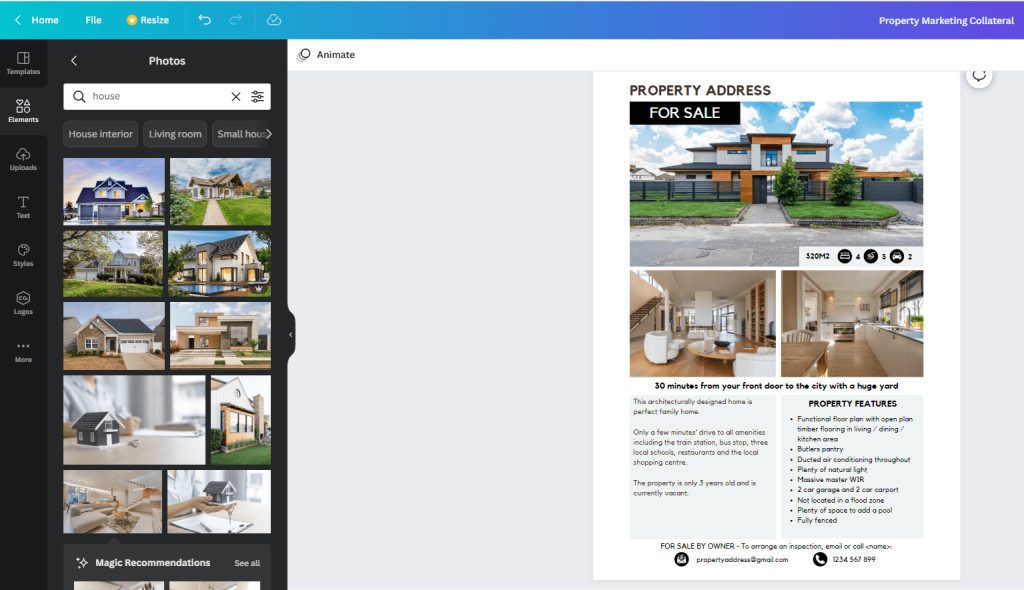
Despite letter box dropping almost 2,000 flyers in the suburb the property is located in and some of the surrounding suburbs (which took 2 of us about 8 hours), I didn’t see a difference in the number of open homes, nobody came to an open home holding one of those flyers either. If I sold another property myself, I would probably just do 500 letterbox drops in the immediate suburb, or not bother with the letterbox drop at all.
How and when I held the open homes
We held open homes at these times:
- Saturday 10 – 10:30am
- Saturday 12 – 12:30pm
- Tuesday 12:30 – 1pm
- Thursday 12:30 – 1pm
It was actually the two midweek open homes that the reasonable offers came from, not the Saturday open home. I couldn’t hold an open home on a Sunday as the property was tenanted, nor could I hold them after 6pm on a weekday.
The open homes were 30 minutes however if people arrived towards the end, we extended it to 45 minutes.
Keeping everything organized
- I created a spreadsheet with countdown / timeline
- I created a new email address for buyers to contact me via. I wish I had set up a separate email address when I first bought the property rather than use my personal email address
- Email templates – I used templates when buyers would enquire asking the same things
- Made a simple contact list in Microsoft Word, printed it out and put it on a clipboard for buyers to write their name, email address and phone number which I then recorded in a Google sheets spreadsheet. I used Google Sheets so both myself and my sister could access the spreadsheet. I didn’t want to put this on an iPad and take it to the open homes as then there’d be no backup and an iPad iust another thing to carry and keep track of at the open home
- Used a plastic document wallet for the different types of brochures
- Kept the signs separate so it was quicker to set up for the open home
Email templates
Here are some examples of email templates we used which you may find helpful:
Hi <name>,
Thank you for your offer. At this time we are seeking a higher offer. Please let us know if you would like to revise your offer and if you have any other questions about the property.
Kind Regards,
Hi <name>,
Pets are subject to body corporate approval. A previous tenant had 2 small dogs in the apartment. The body corporate committee have also previously approved a bird in one of the units. I expect they would approve an application for a cat, however it will likely take a week for the committee to get back to me with the formal confirmation.
Kind Regards,
Hi <name>,
The body corporate fees are comparable to other unit complexes in this suburb. Body corporate fees include administration costs (e.g. annual audit, safety audit, fire door inspection) as well as building maintenance including the lift, hot water system, roller door, cleaning and gardening of common property, emergency lights replacement and the like. There is a healthy <$xx> in the sinking and administration fund.
There is a 20% discount if you pay the body corporate fees by the due date each quarter.
Kind Regards,
Would I sell a property myself again?
100% yes! I will never use a real estate agent when I can just do it myself, the way I want to, with full control. I can sell it for the price I want without being pressured by a real estate agent and I don’t have to hand over thousands of dollars to someone else.
I hope this post gave you the confidence to try selling your property without a real estate agent!
More useful property tools
- First home budget spreadsheet
- How I use excel to organize a home renovation
- Property search spreadsheets
Found this post helpful? Pin it!
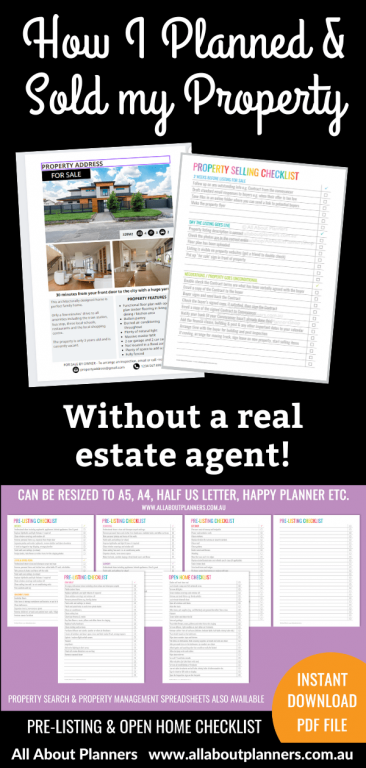
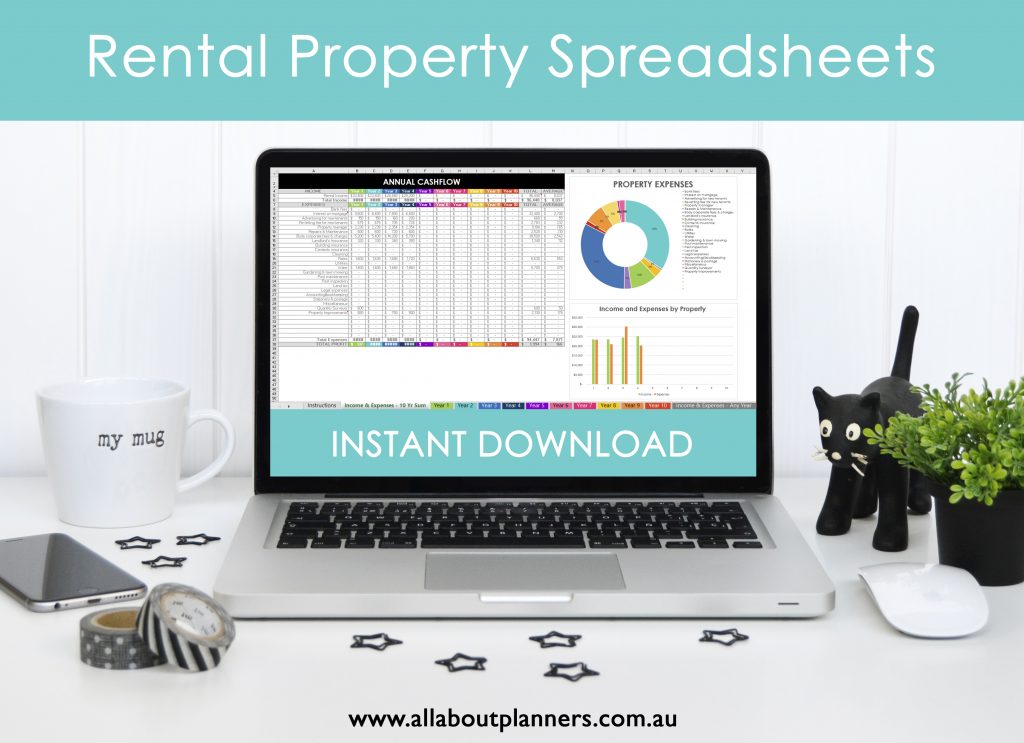
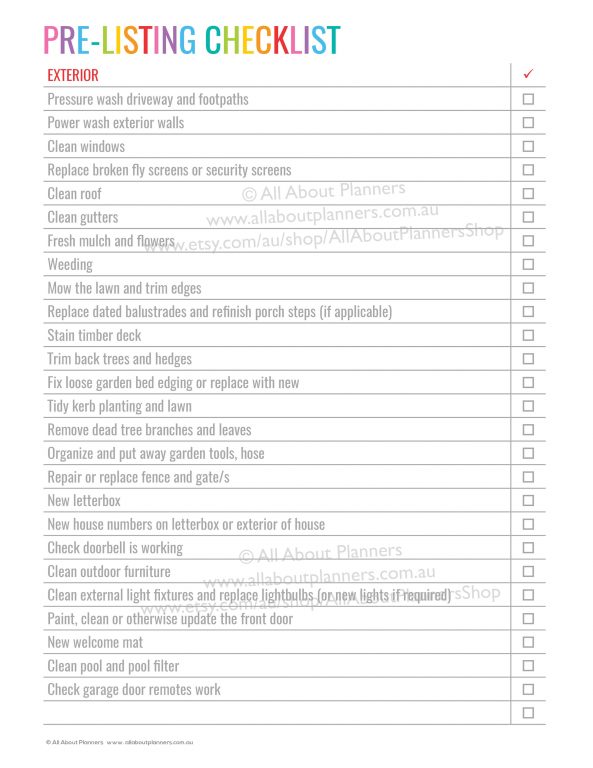
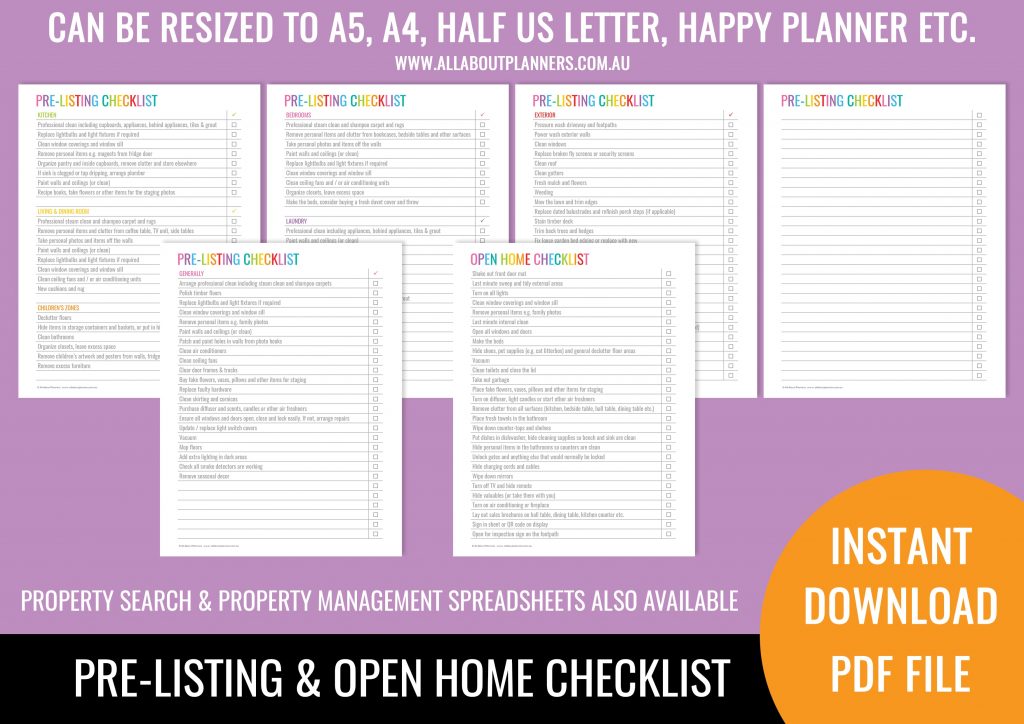
I’m not selling property atm but I have bought and sold property in the past and your post is excellent with the “how-to’s” and advice. I’ve been to the odd open day out of curiosity (local potential selling prices compared to the value I feel the property has for investment purposes) and some real estate agents are a bit uninformative about costs etc (land rates/water rates etc) and you need to do this work yourself. Your information, I feel, was excellent. If they treat potential buyers in this way I dread to think how they treat the persons who are selling the property that are paying them.